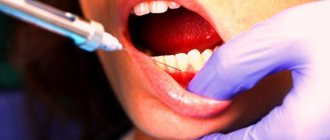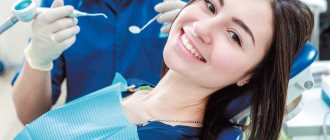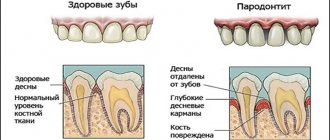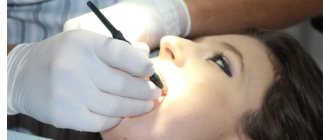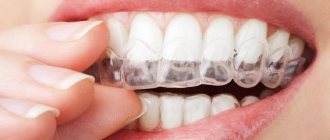Dentistry / Dentistry for pregnant women / Pain relief during pregnancy
One of the most common questions that specialists from SCNT “NOVOSTOM” have to answer is the possibility of using painkillers by pregnant women. Alas, it is impossible to answer unequivocally.
Pregnancy provokes hormonal changes in a woman’s body. And problems with teeth against this background are not uncommon. In this case, the body works on the principle “all the best goes to the child,” which is why women often experience a lack of nutrients, including calcium, which is necessary for teeth. In addition, if the oral cavity has not been sanitized, during pregnancy the process of reproduction of harmful bacteria is activated.
Dentists at the NOVOSTOM clinic recommend seeking professional orthodontic treatment immediately after the first symptoms occur. The discomfort a woman experiences due to toothache has a negative impact on the fetus. Therefore, it is better to immediately contact a specialist. But if this is not possible, you may need to take painkillers.
Introduction
Migraine is a common primary form of headache (TH), which manifests itself in the form of repeated attacks, often accompanied by nausea, vomiting, photo- and phonophobia.
The prevalence of migraine, according to various estimates, ranges from 2.6% to 21.7%, and the average rate is 14.7% [1]. In Russia, the prevalence of migraine reaches 20.8%, which is approximately more than 30 million people [2]. The prevalence of migraine in women is more than 2 times higher than that in men, and the highest prevalence of migraine within the female population occurs during reproductive age [3]. For this reason, issues of tactics for managing patients with migraine during pregnancy are of high relevance. Issues of pregnancy planning, as well as rules for taking medications for pain relief and approaches to preventive treatment of migraine during pregnancy are discussed very often.
When can anesthesia be used?
Like any medical intervention, the unreasonable use of anesthesia during pregnancy is undesirable. There are cases when the problem can be eliminated without pain relief. For example, when treating superficial caries or low individual tooth sensitivity, treatment can be carried out without anesthesia.
The use of anesthesia for pregnant women becomes necessary in the following cases:
- Treatment of deep caries. As a rule, this disease is accompanied by acute toothaches and, if not treated in a timely manner, can lead to complications in the form of pulpitis and periodontitis. Inflammation of the dental pulp allows pathogenic bacteria to enter the bloodstream and spread throughout the body. To prevent their negative impact on the baby’s health, it is necessary to stop tooth decay in a timely manner.
- Removal of a tooth. If a tooth is destroyed and causes inflammation, bleeding and pain, it is recommended to remove it without waiting for the end of pregnancy. In this case, you also cannot do without the use of anesthesia.
The course of migraine during pregnancy
In 50–70% of women during pregnancy, migraine without aura improves [4]. Migraine attacks become mild, extremely rare, and in most patients in this group the migraine completely disappears. Improvement occurs after the first trimester, starting from the 12th–14th week. pregnancy. This is due to the fact that by the beginning of the second trimester, the level of estrogen stabilizes and begins to increase, and its fluctuations stop (Fig. 1). Migraine with aura stops less often during pregnancy, in approximately 40% of patients.
At the same time, if headache persists during this period, it is necessary to carry out differential diagnosis and determine the form of headache. Alarming symptoms during pregnancy are:
the appearance of a new, unusual headache;
a sharp increase in migraine attacks;
the addition of new, unusual symptoms of hypertension, including visual impairment, sensitivity, aphasia, paresis of the limbs;
the appearance of migraine aura in patients with previous migraine without aura;
increased blood pressure during hypertension;
convulsions.
The presence of active migraine during pregnancy does not affect the course of pregnancy itself and the development of the fetus, but increases the risk of preeclampsia and gestational hypertension. Moreover, the persistence of active migraine, especially migraine with aura, during pregnancy increases the risk of acute cerebrovascular accidents (ACVA) by 15–17 times [5]. The prevalence of stroke during pregnancy and the early postpartum period is 34.2 cases per 100,000 births [5].
What to do if your tooth hurts during pregnancy and you can’t get to the doctor
For starters, you can drink something painkiller. Paracetamol is considered the safest. Unlike other analgesics, if the recommended dosages are followed, it will not harm the fetus.
Before meeting with your doctor, you can also try to reduce pain with warm rinses. For this, decoctions with an anti-inflammatory effect are used: oak bark, sage, chamomile. You can rinse approximately once every one and a half to two hours.
Severe pain is relieved with novocaine applied to a tampon and applied to the gum in the area of the diseased tooth. However, this method should be used with caution during pregnancy. In any case, you cannot self-medicate; you should quickly see a dentist.
Sign up at Clarimed at any time convenient for you, we work around the clock. Call: +7 (495) 316-96-16 or sign up at klarimed24.ru. If the pain is severe, we will try to see you immediately.
During pregnancy, you need to fill your diet with calcium-containing foods: milk, cottage cheese, cheese
Stopping attacks
The selection of drug therapy for patients with migraine during pregnancy poses significant difficulties. The severity of migraines can be especially high during the first trimester. Full-blown, unrelieved migraine attacks are often accompanied by nausea, vomiting and lead to unnecessary suffering and dehydration, especially in patients suffering from early toxicosis. Despite the desire to avoid taking medications (especially in early pregnancy) to minimize the risk of fetal developmental disorders, many patients with hypertension begin to take analgesics uncontrollably. Therefore, the importance of preliminary counseling and education of patients on the proper control of hypertension cannot be overemphasized.
Non-pregnant women are recommended to take medications to relieve migraine attacks as early as possible, no later than 1 hour after the onset of the attack. This approach allows you to speed up relief and completely stop a migraine attack in a short time. Pregnancy is the only period in a woman’s life when this recommendation can be temporarily ignored. For patients seeking to minimize drug use, a stepwise approach may be recommended, in which treatment of mild to moderate attacks begins with non-drug methods.
If the patient decides not to use analgesics, control of nausea becomes a priority to avoid dehydration. Patients should avoid strong odors and drink more fluids, such as juices diluted 1:1 with water. Feelings of nausea can also be reduced by eating easily digestible foods, such as crackers, applesauce, bananas, rice, and pasta. Metoclopramide or ondansetron can also be used [6].
Neurostimulation methods play a major role in non-drug approaches to the treatment of migraine. The only device registered in Russia for non-invasive transcutaneous stimulation of the supraorbital nerve - Cefaly (Cefaly®) - is specially designed for the treatment of migraines and can be a good alternative to medications for relieving migraine attacks. Using the Cefaly device at the very beginning of an attack allows you to reduce the intensity of headaches and in some cases completely stop the attack. Thus, the intensity of migraine pain decreases by 4.3 points after 1 hour [7]. Cefaly can also be used in conjunction with pain medications to increase their effectiveness.
Despite the fact that, in general, paracetamol is less effective for relieving an acute attack of migraine than acetylsalicylic acid and nonsteroidal anti-inflammatory drugs (NSAIDs), its safety during pregnancy is higher [6]. Caffeine, which has the ability to enhance the analgesic effect, is an important addition to painkillers. Adding 100 mg of caffeine to the analgesic increases its effect by 1.5 times.
The safety of NSAIDs is controversial [6]. Prescribing NSAIDs in the first trimester may be associated with an increased risk of miscarriage and the development of congenital anomalies. Taking NSAIDs and aspirin in the third trimester can lead to premature closure of the ductus arteriosus
. For these reasons, the use of NSAIDs should be limited to the second trimester. It is especially important to stop taking them after the 32nd week. Taking high doses of aspirin may also increase the risk of bleeding.
Triptans are the most effective analgesics for the relief of migraine attacks. The safety of triptans during pregnancy is assessed through pregnancy registries, where a huge amount of data has now been accumulated for sumatriptan, for example. Despite the prohibition of its use during pregnancy indicated in the official instructions for the use of sumatriptan, there is no evidence of an increased risk of congenital malformations when taken by pregnant women [8]. Patients who took triptans in early pregnancy (without knowing they were pregnant) should be advised that the likelihood of adverse effects of this drug on the fetus is extremely low. Women who experience severe, disabling migraine attacks that cause vomiting may be advised to use triptans during pregnancy. To date, this information has not been included in official recommendations for the treatment of migraine, but the safety of sumatriptan is confirmed by the analysis of a huge number of observations and expert recommendations.
It should be borne in mind that the safety of triptans varies. Sumatriptan, as the most hydrophilic of the triptans, has difficulty penetrating the placental barrier, while other triptans (including eletriptan) are lipophilic.
Prednisolone can only be used as an “ambulance” remedy in the event of a prolonged and severe migraine attack [9]. The use of prednisolone is preferable to dexamethasone, since the latter penetrates the placenta better. Nuchal nerve blocks with lidocaine, bipuvacaine and/or a corticosteroid can be used as an ambulance to relieve severe attacks.
Pain relief without drugs
So, if a woman is in good health and there are no complications during labor, then you can try to avoid painful sensations using various physiological methods: massage, water procedures, gymnastics and special breathing. All processes in the body are interconnected: if a woman is afraid, then a muscle spasm occurs, causing oxygen deficiency in the blood vessels and acute pain. Tension of the facial muscles causes a response spasm of the uterine uterus and delayed dilation of the cervix. Based on these data, when contractions occur, you need to relax and calm down, feeling that the pain is going away every minute.
Of course, it is not easy to immediately master such a technique, so during pregnancy it is necessary to attend special courses for expectant mothers, which teach the correct breathing tactics at different stages of childbirth, show basic relaxation techniques and exercises to relieve pain. Such courses can and should be attended with a partner, since many exercises are based on teamwork.
For physical exercise, you don’t need any special devices, you just need to listen to yourself and change positions more often, since physical activity makes labor easier and reduces pain. If the doctor has not prescribed bed rest, you need to walk more, preferably lying only on your side. Sitting is undesirable, as this creates pressure on the perineum.
Many women benefit from water procedures, but they can only be carried out if the water has not broken, since the risk of infection is very high. A warm bath with hydromassage is a great way to relieve tension and help you relax, but either a partner or someone from the medical staff must be present during the procedure. You can also use a shower cabin, directing streams of water to your back and lower abdomen. The water should be at a temperature of about thirty-six degrees so as not to cause bleeding. Aromatherapy, self-hypnosis and other techniques, including massage, are also quite effective in relieving severe pain. If desired, you can resort to a variety of techniques to minimize pain, but before using them, you should definitely talk with the doctor leading the birth.
Preventative treatment
The attending physician must promptly identify the group of patients in whom preventive treatment of migraine will be most successful. While most pregnant women begin migraine remission at the end of the first trimester, others experience migraine remission by the 10th–12th week. Frequent attacks may persist, which will most likely indicate the persistence of headache throughout pregnancy. Refusal to treat such patients can lead to malnutrition, dehydration, the development of affective disorders and a significant decrease in quality of life.
Preventive treatment of migraine is necessary in the following cases:
high frequency of attacks (more than 3 days a week);
the presence of severe or prolonged attacks;
significant disability;
dehydration and malnutrition;
poor response to analgesics.
The current frequency of headaches and the effectiveness of the analgesics used should be monitored using a headache diary. For patients who require preventive treatment, it is necessary to select the optimal combination of drug and non-drug approaches.
There are a number of non-drug methods that can effectively manage hypertension during pregnancy and are an important addition to pharmacological methods; when combined, the amount of drugs used during pregnancy and lactation is reduced. Relaxation techniques, cognitive behavioral therapy and biofeedback can be used during pregnancy.
Trigeminal neurostimulation also plays a major role in the preventive treatment of migraine during pregnancy. Regular use of Cefaly daily for 20 minutes, preferably in the evening, leads to a 2-fold reduction in migraine headache attacks in 38% of patients with episodic migraine and 35% of patients with chronic migraine [10, 11]. The high safety of this method (the probability of adverse events is 2–3%) allows it to be used without fear during pregnancy. It is also important that the Cefaly device has a mild sedative effect [12] and is not prohibited for use during pregnancy.
Information about the safety of drugs is collected through clinical trials of their use in the treatment of other diseases, including mood disorders, cardiovascular diseases and epilepsy. The safety of most drugs during pregnancy has not been directly assessed, but accumulated data have allowed these drugs to be assigned a certain safety category. In addition, the choice of drugs for the treatment of migraine in pregnancy may be based on additional information about the safety of a number of drugs that are used in pregnancy to treat hypertension, depression and epilepsy.
If it is necessary to prescribe drug therapy to reduce migraine attacks, it is recommended to start with the use of β-blockers. Due to its widespread use in the treatment of arterial hypertension during pregnancy, propranolol (anaprilin) is considered the drug of first choice for the preventive treatment of migraine [13]. At the same time, taking β-blockers is associated with a risk of hypoglycemia, hypotension, bradycardia and respiratory disorders in the newborn. The drug should also be used with caution in patients with bronchial asthma, a tendency to arterial hypotension and bradycardia. In the absence of propranolol or if there are contraindications to it, metoprolol can be used. It is recommended to gradually reduce the dose of beta-blockers during the last weeks of pregnancy (starting from the 36th week) and discontinue them at least 2-3 days before delivery.
No adverse effects on fetal development have been demonstrated with the use of calcium channel blockers, but insufficient data and the low effectiveness of verapamil do not allow it to be recommended for widespread use for the preventive treatment of migraine during pregnancy [13].
Lisinopril exhibits a teratogenic effect when used in the 2nd and 3rd trimesters and should be discontinued. Candesartan, which has a mechanism of action similar to lisinopril, should also not be used to treat migraine in pregnant women [14].
Despite the high effectiveness of antiepileptic drugs in the treatment of migraines, their use during pregnancy is prohibited. Valproic acid preparations are absolutely contraindicated during conception and pregnancy due to their teratogenic effect (disrupting the development of the fetal neural tube) and blood clotting disorders in the mother and fetus. In addition, data have accumulated on the possible teratogenic effects (development of hypospadias, cleft lip and palate) of topiramate [14].
Gabapentin has low effectiveness in the preventive treatment of migraine; the safety of its use during pregnancy has been poorly studied. Its use should be stopped in the third trimester due to its possible effect on bone development [6].
Tricyclic antidepressants are highly effective in the preventive treatment of migraine. Amitriptyline is relatively safe during this period and is the second choice drug for the preventive treatment of migraine [6, 13, 15].
The use of the serotonin and norepinephrine reuptake inhibitor venlafaxine in the third trimester increases the risk of developing behavioral syndrome of newborns by 3 times. Symptoms are usually mild in severity.
The safety of botulinum toxin type A preparations for the treatment of migraine during pregnancy has not been studied. At the same time, data have accumulated on the absence of teratogenic and embryotoxic effects of botulinum toxin type A in pregnant women who reported using the drug for various indications [16]. At the same time, the use of botulinum toxin for the preventive treatment of migraine during pregnancy is not recommended.
New drugs for the preventive treatment of migraine - antibodies to calcitonin gene-related peptide - erenumab and fremanezumab have not been studied for use in pregnant women and are not recommended for the treatment of migraine.
In addition to the above medications allowed during pregnancy, various vitamins and minerals can be mentioned. In particular, there is evidence of the benefits of magnesium for the preventive treatment of migraine during pregnancy [13, 15]. Pyridoxine (vitamin B6) at a dose of 80 mg/day alone or in combination with other drugs at a dose of 25 mg/day, for example with folic acid, can have a mild preventive effect against migraine.
Table 1 summarizes the safety data of the main groups of drugs used for the preventive treatment of migraine during pregnancy.
Directions for use and dosage during pregnancy
During pregnancy, with uterine hypertonicity, it is permissible to take 6 drotaverine tablets per day. The drug is taken three times a day: two tablets in the morning, afternoon and evening. The safety of the drug for pregnant women has been confirmed by clinical trials: an experiment was conducted in Hungary in which a group of 30 pregnant women regularly taking No-Shpu was examined. No pathologies were identified in newborns; in addition, taking No-Shpa allowed the heart rhythm of children with tachycardia to be normalized.

